As I am getting closer to a full carbon fiber cabinet build I'll post some of the most interesting results here.
This work is focused on a 2-way Purifi PTT6.5 driver selection. The immediate goal is to access the full capability of the PTT. An overarching goal is to incorporate this work into an off-grid battery powered system. Lightweight, portable, and compact are priorities (aside from sound quality).
Currently I have made two attempts at an iso-grid style of construction. The initial concept was to use a woven fabric to mold two shells that will then be bonded under tension. This turned out to not be viable as the fabric is not able to drape into the opposing contours; it's basically fighting itself.
The second attempt utilized yarn that was placed into the ribs of the mold. An epoxy "core" then fills the remaining space until even with the mold face. Cloth is then applied to complete the sandwich construction. This attempt proved viable which brings the current attempts to date.
From the second strategy it is clear that some version of this technique could be used to create excellent results-- meaning smooth surface, no voids, good mechanical performance, etc.
Finally, the always entertaining failure test was performed. The highly [un]scientific test consisted of standing on the panel balanced over a 8" pipe until it failed. The combined cross section of ribs at the narrowest point is about 1.25" X .25" with a thin carbon shell. Rough guestimate puts the failure around 100ksi to 150ksi which is pretty good in my opinion.
Why does failure matter for a cab? The plan is to place the panels in tension. One way to achieve this is to take one panel and bend it into a curve, then take another and bond the two into the tensioned form. A possible problem in doing this is that the panel is already very stiff and bending it can induce considerable strain. So it will be necessary to keep the curvature profile within acceptable limits of the panel's strength. A benefit if curving the panels is free volume creation. Ok, enough rambling.....
This work is focused on a 2-way Purifi PTT6.5 driver selection. The immediate goal is to access the full capability of the PTT. An overarching goal is to incorporate this work into an off-grid battery powered system. Lightweight, portable, and compact are priorities (aside from sound quality).
Currently I have made two attempts at an iso-grid style of construction. The initial concept was to use a woven fabric to mold two shells that will then be bonded under tension. This turned out to not be viable as the fabric is not able to drape into the opposing contours; it's basically fighting itself.
The second attempt utilized yarn that was placed into the ribs of the mold. An epoxy "core" then fills the remaining space until even with the mold face. Cloth is then applied to complete the sandwich construction. This attempt proved viable which brings the current attempts to date.
From the second strategy it is clear that some version of this technique could be used to create excellent results-- meaning smooth surface, no voids, good mechanical performance, etc.
Finally, the always entertaining failure test was performed. The highly [un]scientific test consisted of standing on the panel balanced over a 8" pipe until it failed. The combined cross section of ribs at the narrowest point is about 1.25" X .25" with a thin carbon shell. Rough guestimate puts the failure around 100ksi to 150ksi which is pretty good in my opinion.
Why does failure matter for a cab? The plan is to place the panels in tension. One way to achieve this is to take one panel and bend it into a curve, then take another and bond the two into the tensioned form. A possible problem in doing this is that the panel is already very stiff and bending it can induce considerable strain. So it will be necessary to keep the curvature profile within acceptable limits of the panel's strength. A benefit if curving the panels is free volume creation. Ok, enough rambling.....
Attachments
-
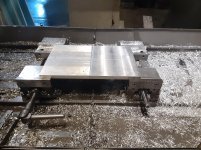 20210710_082708.jpg1,010 KB · Views: 352
20210710_082708.jpg1,010 KB · Views: 352 -
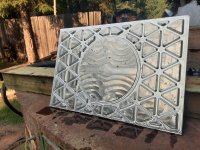 20210710_183457.jpg1,009.8 KB · Views: 347
20210710_183457.jpg1,009.8 KB · Views: 347 -
 20210710_225847.jpg720.7 KB · Views: 343
20210710_225847.jpg720.7 KB · Views: 343 -
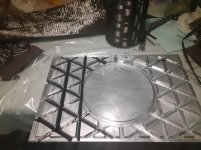 20210711_131139.jpg632.5 KB · Views: 339
20210711_131139.jpg632.5 KB · Views: 339 -
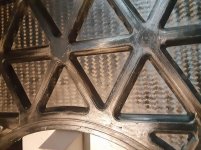 20210722_210010.jpg901.4 KB · Views: 342
20210722_210010.jpg901.4 KB · Views: 342 -
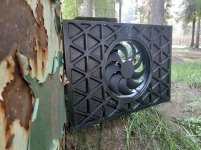 20210725_100925.jpg822.6 KB · Views: 229
20210725_100925.jpg822.6 KB · Views: 229 -
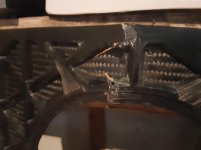 20210727_162253.jpg646.4 KB · Views: 235
20210727_162253.jpg646.4 KB · Views: 235 -
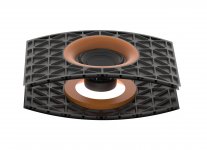 untitled.19633.jpg252.7 KB · Views: 222
untitled.19633.jpg252.7 KB · Views: 222
Interesting to be sure. Is the use of a stressed member necessary? My experience with composites is modest, even more so with carbon. To date I'm only familiar with molding carbon to finish shape and when I have witnessed any significant flex, catastrophic failure was usually the result.
Carbon fiber is used for high strength systems, and I think it is reflective, you need a softer coating inside to control reflections and wall vibrations.
@seventenths
Induced stress is not necessarily required and you can build up the cross sections for a thickness more appropriate to one way or another. I won't be surprised if it turns out taking more effort to implement than is worth doing. Just a recipe in progress so far.
@NareshBrd
Yes. I'm assuming there will be some manner of outfitting the interior. Constrained layer is good possibility here; just a guess though. And of course stuffing and so on.
Induced stress is not necessarily required and you can build up the cross sections for a thickness more appropriate to one way or another. I won't be surprised if it turns out taking more effort to implement than is worth doing. Just a recipe in progress so far.
@NareshBrd
Yes. I'm assuming there will be some manner of outfitting the interior. Constrained layer is good possibility here; just a guess though. And of course stuffing and so on.
Look at the Boeing 787 literature, stressed members can have sudden failures, and are to be avoided.
Has anybody ever used composite building panels, the kind used for cladding buildings, as a speaker cabinet material?
Has anybody ever used composite building panels, the kind used for cladding buildings, as a speaker cabinet material?
@NareshBrd
Not too worried about it as I don't plan on transporting passengers with it 😉 As far as working with carbon, all failures are sudden, prestressed or no.
About the composite building panels, yeah I'm pretty sure there are a few popular products but don't recall which the good ones are.
Not too worried about it as I don't plan on transporting passengers with it 😉 As far as working with carbon, all failures are sudden, prestressed or no.
About the composite building panels, yeah I'm pretty sure there are a few popular products but don't recall which the good ones are.
Make it in a way that is not stressed then, why do you need a stressed member?
By the way, I have come across carbon fiber (blade runner) prosthetic feet, and also off road Jeep / similar 4 x 4 leaf springs which are subject to sudden as well as cyclic stress.
By the way, I have come across carbon fiber (blade runner) prosthetic feet, and also off road Jeep / similar 4 x 4 leaf springs which are subject to sudden as well as cyclic stress.
@NareshBrd
I've often wanted to make carbon springs; that Jeep example sounds awesome. If they were regular coil springs I can see how that may be a bad fit. If you haven't yet, check out carbon Belleville disc spring suspension designs. I think that might be a more stable geometry and if one failed it wouldn't be as dangerous as they are a stacked plurality.
I share your interest regarding failure modes but it's just not a concern to me personally for this specific use case. I can't think of a more benign application to "catastrophically" fail. Consider: I just intentionally broke one between my feet and lived. Not only did I live, I didn't even flinch.
Think about the cross section, this is a thin skin. This is not a 1/4" solid UHM panel that has 4000lbs of total force acting on it. This is an extreme, not plausible, deliberate destruction that takes 100lbs and concentrates it over a tiny area.
Not saying these things can't/don't happen. Am saying no sleep lost over the very unlikely event that a one pound panel goes "tink" during a heavy metal sesh 😀 But it aint gonna-
I've often wanted to make carbon springs; that Jeep example sounds awesome. If they were regular coil springs I can see how that may be a bad fit. If you haven't yet, check out carbon Belleville disc spring suspension designs. I think that might be a more stable geometry and if one failed it wouldn't be as dangerous as they are a stacked plurality.
I share your interest regarding failure modes but it's just not a concern to me personally for this specific use case. I can't think of a more benign application to "catastrophically" fail. Consider: I just intentionally broke one between my feet and lived. Not only did I live, I didn't even flinch.
Think about the cross section, this is a thin skin. This is not a 1/4" solid UHM panel that has 4000lbs of total force acting on it. This is an extreme, not plausible, deliberate destruction that takes 100lbs and concentrates it over a tiny area.
Not saying these things can't/don't happen. Am saying no sleep lost over the very unlikely event that a one pound panel goes "tink" during a heavy metal sesh 😀 But it aint gonna-
Last edited:
🙂To each his own...
My uncle made leaf springs as an employee from 1964-77
1978-2012 he ran his own unit.
I was his assistant during the 80s in college vacations.
I know a bit about springs.
Getting coil spring rates in composite Belleville washers is something hard to believe on a production basis.
My original question about the need for a stressed member still stands.
Also, after curing, how will you keep it stressed?
What acoustic advantage is gained by doing so?
My uncle made leaf springs as an employee from 1964-77
1978-2012 he ran his own unit.
I was his assistant during the 80s in college vacations.
I know a bit about springs.
Getting coil spring rates in composite Belleville washers is something hard to believe on a production basis.
My original question about the need for a stressed member still stands.
Also, after curing, how will you keep it stressed?
What acoustic advantage is gained by doing so?
Last edited:
Uh, wow. The tooling required to make your own panels! This stuff probably doesn't build with a paintbrush & rasp like they build surfboards of glass fiber & foam blocks.
I looked at building a 177 L 30 hz woofer enclosure with this carbon fiber+foam material: McMaster-Carr
but a 24"x48"x1/4" panel is $1063 and I needed 5.
Object was to save weight. Lifting 82 lb speakers onto 6' high poles is not on the agenda at my age. The transducer is only 17 lb.
I looked at building a 177 L 30 hz woofer enclosure with this carbon fiber+foam material: McMaster-Carr
but a 24"x48"x1/4" panel is $1063 and I needed 5.
Object was to save weight. Lifting 82 lb speakers onto 6' high poles is not on the agenda at my age. The transducer is only 17 lb.
Last edited:
Building cladding panels are about $1.50 US per square foot here, the kind used for exteriors. Aluminum composite panels they are called.
PVC foam board, as intended for indoor furniture, is slightly cheaper.
You can consider these light weight materials, resonance will be a problem, you will need to use something inside the box.
PVC foam board, as intended for indoor furniture, is slightly cheaper.
You can consider these light weight materials, resonance will be a problem, you will need to use something inside the box.
Beware of breathing protection when sawing and sanding carbon. Particles not good for lungs - will give you lung cancer as years go by...
//
//
I want to know more about the manufacturing process! Is this all equipment you have home? What kind of vacuum forming is that?
There was a cat over on Talkbass IIRC, who was building cabinets using XPS sheets, skinned with fiberglass. They were intended to be used with Neo drivers I think, so that you'd have a nice light bass cabinet for gigging. It always made me wonder what kind of setup one could make for PA or HiFi duties. I am certain the sound would be colored by such an enclosure.
Stepping upto carbon fiber makes me think that you'll encounter less issues than with fiberglass for starters. Also, if done right, the strength of carbon composite products can be insane. Look at F1 parts etc... That said, I think there is a ton of engineering principles at work, and not just dependant on material alone.
This thread has some interesting potential. I like seeing people try new things.
Stepping upto carbon fiber makes me think that you'll encounter less issues than with fiberglass for starters. Also, if done right, the strength of carbon composite products can be insane. Look at F1 parts etc... That said, I think there is a ton of engineering principles at work, and not just dependant on material alone.
This thread has some interesting potential. I like seeing people try new things.
Oh man, this composites stuff is a lot of fun and I'm really happy to see it here. Way to go on prototyping molds and pumping out these concepts!
I've made things like stressed panels and gearboxes, and even hydrofoil wings, but your structural testing reminds me of the skidplate-[un]science we did - throwing steel L-channel like spears at the panels 🙂
My $.02 on the enclosure is that I'm guessing it's likely to need CLD or maybe a dual-wall sand-filled-baffle that you can drain and refill for portability.(..?)
Looking at the Satori Textreme responses, they're all definitely hitting their 1st, 2nd, etc vibration modes as they go past ~5kH range, even if they do bond the cones to the VC at critical locations. The epoxy makes it more damped/controlled than a metal, but I'm not sure compared to paper, there's lots of coated paper cones out there. But they all resonate based on mass and stiffness.
Everything's a spring, though (except water). Maybe that ice-hotel in Norway needs speaker boxes..
Non-audio OT warning for the rest of this:
I made carbon coil springs with a professor back in school, the trick was to bond them as opposite-direction spirals to help constrain the thing under fatigue loading. Also, although Belleville spring washers are more exponential than linear, you can get to linear by stacking them in progressive sequences of cone-up & down, so that some are going flat while others are still compressing
So many failure modes with composites, from things like shear-failure between layers, to micro-buckling of the fibers under compression, to all the issues from trying to fasten things to the actual panel. But they work great as pressure vessels (which is this).
The space shuttles all still used the same kevlar spheres which that same professor made for them in the 70's. He ended class once by looking and his phone and saying "Hmm, it's NASA..." Kevlar absorbs moisture and they busted a backup one they'd kept in humid Florida storage
Anyway, the Tsai-Wu criteria is a nice resource for some models behind loading conditions if you're interested, but I think your testing/listening is totally valid for this. It's sorta interesting that each individual fiber strand is full of weak sections, and breaks almost immediately on initial proof-loading, but the shear strength of the glue means that the rest of that broken fiber is supporting load only a few fiber-diameters away from the break
Long term cyclic fatigue might be a question though. I have a few friends that worked the 787 design and manufacturing. That thing has a titanium & carbon bonded I-beams that runs through the wings and under the fuselage, even though the panels are structural
Aluminum wing panels will fatigue crack at the rivets, but at a slow enough rate that you can inspect and replace before they unzip. But if you don't notice it, at least the crack will terminate at the end of that single panel.. Boeing couldn't show the FAA that same level of backup-protection on the continuous carbon skins, so they had to go extra thick and design for infinite fatigue life.. Good for us, but the plane didn't get nearly as light as going "all carbon" initially seemed. Not a great topic for the person sitting next to you on the flight either way though
I've made things like stressed panels and gearboxes, and even hydrofoil wings, but your structural testing reminds me of the skidplate-[un]science we did - throwing steel L-channel like spears at the panels 🙂
My $.02 on the enclosure is that I'm guessing it's likely to need CLD or maybe a dual-wall sand-filled-baffle that you can drain and refill for portability.(..?)
Looking at the Satori Textreme responses, they're all definitely hitting their 1st, 2nd, etc vibration modes as they go past ~5kH range, even if they do bond the cones to the VC at critical locations. The epoxy makes it more damped/controlled than a metal, but I'm not sure compared to paper, there's lots of coated paper cones out there. But they all resonate based on mass and stiffness.
Everything's a spring, though (except water). Maybe that ice-hotel in Norway needs speaker boxes..
Non-audio OT warning for the rest of this:
I made carbon coil springs with a professor back in school, the trick was to bond them as opposite-direction spirals to help constrain the thing under fatigue loading. Also, although Belleville spring washers are more exponential than linear, you can get to linear by stacking them in progressive sequences of cone-up & down, so that some are going flat while others are still compressing
So many failure modes with composites, from things like shear-failure between layers, to micro-buckling of the fibers under compression, to all the issues from trying to fasten things to the actual panel. But they work great as pressure vessels (which is this).
The space shuttles all still used the same kevlar spheres which that same professor made for them in the 70's. He ended class once by looking and his phone and saying "Hmm, it's NASA..." Kevlar absorbs moisture and they busted a backup one they'd kept in humid Florida storage
Anyway, the Tsai-Wu criteria is a nice resource for some models behind loading conditions if you're interested, but I think your testing/listening is totally valid for this. It's sorta interesting that each individual fiber strand is full of weak sections, and breaks almost immediately on initial proof-loading, but the shear strength of the glue means that the rest of that broken fiber is supporting load only a few fiber-diameters away from the break
Long term cyclic fatigue might be a question though. I have a few friends that worked the 787 design and manufacturing. That thing has a titanium & carbon bonded I-beams that runs through the wings and under the fuselage, even though the panels are structural
Aluminum wing panels will fatigue crack at the rivets, but at a slow enough rate that you can inspect and replace before they unzip. But if you don't notice it, at least the crack will terminate at the end of that single panel.. Boeing couldn't show the FAA that same level of backup-protection on the continuous carbon skins, so they had to go extra thick and design for infinite fatigue life.. Good for us, but the plane didn't get nearly as light as going "all carbon" initially seemed. Not a great topic for the person sitting next to you on the flight either way though
Last edited:
Actually, hand lay up process can be used in any epoxy resin system, the fibers can be glass, Kevlar, Nomex, Carbon, etc. and combinations too. The resins can vary too.
The more complex processes add machine layering, special weave patterns if needed, mechanical spraying, vacuum treatment and autoclave curing
The more complex processes add machine layering, special weave patterns if needed, mechanical spraying, vacuum treatment and autoclave curing
I looked at building a 177 L 30 hz woofer enclosure with this carbon fiber+foam material: [URL="https://www.mcmaster.com/1987N13" said:McMaster-Carr[/URL]
but a 24"x48"x1/4" panel is $1063 and I needed 5.
Object was to save weight. Lifting 82 lb speakers onto 6' high poles is not on the agenda at my age. The transducer is only 17 lb.
I greatly sympathize with not lifting heavy stuff. Those panels would have been a big waste of money I think. 1/4" is maybe too thin even if they were solid carbon. You want something like a 1/2" or greater sandwich panel with a honeycomb core. You can homebrew your own without equipment and save major bucks. Making craft style flat panels using just a flat table does work. Keep it basic and you don't need specialty gear. Combining everything into a completed cab is the trickier part, but definitely doable. As many will point out, getting it to sound good is the biggest challenge.
In one project forming composite I-beams, the factory was using a 8'x16' silicone sheet to lightly vacuum down each section of pre-preg (frozen fibers & uncured epoxy). To warm the fabric from the freezer, there must have been 200 lightbulbs above the silicone sheet.
Looking back now, that would have made a killer load for a 200W+ FirstWatt De'Lite or MR's L'amp -- Class A SE to handle these Purifi drivers on night shift
Looking back now, that would have made a killer load for a 200W+ FirstWatt De'Lite or MR's L'amp -- Class A SE to handle these Purifi drivers on night shift
Oh man, this composites stuff is a lot of fun and I'm really happy to see it here. Way to go on prototyping molds and pumping out these concepts!
I've made things like stressed panels and gearboxes, and even hydrofoil wings, but your structural testing reminds me of the skidplate-[un]science we did - throwing steel L-channel like spears at the panels 🙂
There is something immediately gratifying about breaking a composite and getting the info you want instantly. Lab not required!
Your two cents is what I am assuming to be the case. Something or other will have to accompany the cab interior and or panel internals. I'm not quite there yet. But there is a lot of room to explore, for sure.
I think Boeing must've lifted the spar idea from Sikorski. I used to run a blade repair shop that focused on H53 Sea Stallions. The blades are massive and have a titanium spar with a crabon/nomex airfoil bonded around it. The spar is pressurized (low) and in the event of a crack the pressure drop will move a radioactive plunger past it's shielded cover. The cabin will detect radioactivity and alarm for spar failure. So creative! We had a lot of jokes in the blade shop about whos turn it was to handle the BIM [radioactive] end of the blade. Lot of "protecting my boys" comments when the BIM was crotch level.
Just caught your recent comment. I've definitely seen the o'l lightbulb/heat lamp trick. It's always annoying when having to do that. For small stuff like this project I'm a huge fan of Al mold on a heat plate. Can't beat it, IMO.
Last edited:
- Home
- Loudspeakers
- Multi-Way
- Carbon Composite Panel System